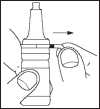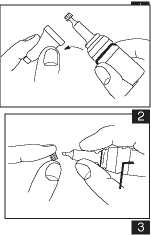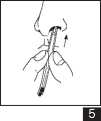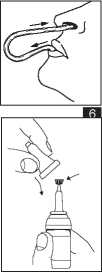Ddavp Intranasal Solution 0.01% W/V
DDAVP / Desmopressin
Intranasal Solution
desmopressin acetate
PATIENT INFORMATION
;g
o
Read all of this leaflet carefully before you start using this medicine.
• Keep this leaflet, you may need to read it again
• If you have further questions, please ask your doctor or pharmacist
• This medicine has been prescribed for you personally , and you should not pass it on to others. It may harm i them even if their symptoms are the same as yours. [• If any of the side effects gets serious, or if you notice i any side effects not listed in this leaflet, please tell your ! doctor or pharmacist.
important things that you need to know:
• DDAVP/Desmopressin Intranasal Solution is used
- to treat patients with multiple sclerosis suffering from nocturia (the need to get up at night to pass urine), when other treatments have failed
- to diagnose and treat cranial diabetes insipidus (a condition that causes extreme thirst and the continuous production of large volumes of dilute urine, when other treatments have failed)
- as a test to check if the kidneys are functioning properly (renal function test)
• You should avoid drinking large amounts of fluid while you are being treated with DDAVP/Desmopressin Intranasal Solution, as this could lead to a build up of water which dilutes the salt in the body. This is a serious problem and may lead to convulsions.
• If you experience unusually bad or prolonged headache, confusion, unexplained weight gain, ankle swelling, nausea or vomiting STOP USING DDAVP/DESMOPRESSIN INTRANASAL SOLUTION. You should tell your doctor immediately or go to the casualty department at your nearest hospital.
Now read the rest of this leaflet. It includes other important information on the safe and effective use of this medicine that might be especially important for you. This leaflet was last updated on 29/11/08
In this leaflet:
1. What DDAVP/Desmopressin Intranasal Solution is and what it is used for
2. Before you use DDAVP/Desmopressin Intranasal Solution
3. How to use DDAVP/Desmopressin Intranasal Solution
4. Possible side effects
5. How to store DDAVP/Desmopressin Intranasal Solution
6. Further information
1. What DDAVP/Desmopressin Intranasal Solution is and what it is used for
2. Before you use DDAVP/Desmopressin Intranasal Solution
There are general restrictions, precautions and warnings which apply to all patients using DDAVP/Desmopressin Intranasal Solution and there are additional restrictions, precautions and warnings which apply depending on the use of DDAVP/Desmopressin Intranasal Solution.
General restrictions (all patients):
Do not use DDAVP/Desmopressin Intranasal Solution if you:
• have a serious heart or kidney disease
• are taking diuretics (water tablets)
• are allergic to any of the ingredients listed in section 6 of this leaflet
• drink unusually large quantities of fluids, including alcohol
You should avoid drinking large amounts of fluid while you are being treated with DDAVP/ Desmopressin Intranasal Solution, as this could lead to a build up of water which dilutes the salt in the body. This is a serious problem and may lead to convulsions.
General precautions and warnings (all patients):
Please consult your doctor before using DDAVP/
Desmopressin Intranasal Solution if you:
• have cystic fibrosis
• have an illness causing fluid and/or electrolyte imbalance e.g. vomiting, diarrhoea, infections or fever
• have a medical condition that could be made worse by fluid and/or electrolyte disturbance. Conditions where your blood sodium levels are too low or you are likely to build up too much water in your body.
Additional restrictions, precautions and warnings:
If you are a patient with nocturia (the need to get up
at night to pass urine) caused by multiple sclerosis:
Do not use DDAVP/ Desmopressin Intranasal Solution:
• if you are over 65 years old
• if you are taking medication for high blood pressure or have been told that your blood pressure is abnormal.
When using DDAVP/ Desmopressin Intranasal Solution:
• fluid intake must be limited to a minimum from 1 hour before taking the dose at bedtime until the following morning (and, in any case, for at least 8 hours)
• stop using DDAVP/ Desmopressin Intranasal Solution when suffering from vomiting and/or diarrhoea until you are better
• avoid swallowing water while swimming to prevent a build up of water in the body.
If you are using DDAVP/Desmopressin Intranasal
Solution for the diagnosis of diabetes insipidus or
for the renal function test:
• fluid intake must be limited and not exceed 500ml from 1 hour before until 8 hours after the dose
;g
o
DDAVP/Desmopressin Intranasal Solution is for nasal use only. It contains Desmopressin acetate, an antidiuretic (reduces urine production). It is used:
• to treat patients with multiple sclerosis suffering from nocturia (the need to get up at night to pass urine), when other treatments have failed
• to diagnose and treat cranial diabetes insipidus (a condition which causes extreme thirst and the continuous production of large volumes of dilute urine). IMPORTANT: This should not be confused with diabetes mellitus (sugar diabetes)
• as a test to check if the kidneys are functioning properly (renal function test)
Patients being treated with DDAVP/Desmopressin Intranasal Solution for any of the conditions listed in this leaflet:
Taking/using other medicines:
Please inform your doctor or pharmacist if you:
• are taking or have recently taken or used any other medicines - even those not prescribed
• are on medication for depression or epilepsy
• are taking a medicine for pain and/or inflammation containing non-steroidal anti-inflammatory drugs (also known as NSAIDs) e.g. indomethacin
Pregnancy:
If you are pregnant or planning a pregnancy, please inform your doctor before you use DDAVP/Desmopressin Intranasal solution as blood pressure monitoring is recommended due to the increased risk of pre-eclampsia (a condition in pregnant women that can cause serious complications). Symptoms of pre-eclampsia include high blood pressure, oedema (swelling due to the build up of fluid) and proteinuria (protein in the urine).
Breast-feeding:
If you are breast-feeding ask your doctor or pharmacist for advice before using DDAVP/Desmopressin Intranasal Solution.
;g
o
PATIENT INSTRUCTIONS
It is important to use your medicine as directed by your doctor. The pharmacy label on the bottle should tell you when to use your medicine and how much to use. If it does not, or you are not sure, ask your doctor or pharmacist.

2. Break security seal and remove plastic cap.
3. Twist off the small seal from the dropper. You can use the same seal reversed to prevent any subsequent leaks.

4. One end of the tube is marked with measurements -take this end of the tube in one hand. With your other hand, place your fingers around the dropper of the bottle (see diagram below). Insert the top of the dropper in a downward position into the end of the tube marked with an arrow and squeeze the dropper until the solution has reached your desired measurement. If you have difficulty filling the tube, you can use a syringe to help with filling the tube.

5. Hold the tube with your fingers approximately 3/4 inch from the end and insert it into the nostril until the tips of the fingers reach the nostril (see diagram)

Like all medicines, DDAVP/ Desmopressin Intranasal Solution can have side effects.
You should avoid drinking large amounts of fluid while you are being treated with DDAVP/Desmopressin Intranasal Solution, as this could lead to a build up of water which dilutes the salt in the body. This is a serious problem and may lead to convulsions.
STOP USING DDAVP/DESMOPRESSIN INTRANASAL SOLUTION if you experience:
• allergic reactions including; itching, skin rashes, swelling of the face, lips or throat, difficulty in breathing, wheeziness, chest tightness or coughing
• unusually bad or prolonged headache
• confusion
• unexplained weight gain
• ankle swelling
• nausea or vomiting
If you experience any of the above side effects, you should contact your doctor or go to the nearest casualty department immediately.
Most people using DDAVP/ Desmopressin Intranasal Solution find it causes them no problems. However, common side effects can include:
• headache
• stomach pain
• blocked or runny nose, nose bleeds
Very rare cases of emotional disorders including aggression in children have also been reported.
If you experience one or more of these side effects or any other undesirable effects, please inform your doctor or pharmacist.
;g
o
w
6.
7.
Put the other end of the tube into your mouth. Hold your breath, tilt back your head and then blow with a short strong puff through the tube so that the solution reaches into your nose.
After use, place the seal on the dropper and close the bottle with the plastic cap. Wash the tube in water and shake thoroughly, until no more water is left. The tube can then be used for the next application.

Keep DDAVP/Desmopressin Intranasal Solution out of the reach and sight of children.
DDAVP/Desmopressin Intranasal Solution should be stored at 2°C - 8°C (in a refrigerator). Keep container in the outer carton.
Use by date: Do NOT use DDAVP/Desmopressin Intranasal Solution past its expiry date on the packaging. The expiry date refers to the last day of the month.
If you are unsure about the storage, ask your pharmacist. It is best to return all old and unused medication to your pharmacist for safe disposal.
Do NOT use more than the prescribed dose in any 24 hour period.
If you have the impression that the effect of DDAVP/ Desmopressin Intranasal Solution is too strong or too weak, talk to your doctor or pharmacist.
The usual doses are:
Nocturia (the need to get up at night to pass urine) caused by multiple sclerosis:
Your doctor will prescribe a dose of 0.1ml to 0.2ml at bedtime. The prescribed dose should NOT be used more than once in any 24 hour period. Your doctor will check your blood pressure and weight at regular intervals.
Diagnosis of diabetes insipidus (adults and children):
Your doctor will prescribe a dose of 0.2ml.
Treatment of diabetes insipidus:
Your doctor will prescribe the dose most suitable for you. The most commonly used doses are:
Adults (including the elderly): 0.1ml to 0.2ml once or twice daily.
Children: 0.05ml to 0.2ml daily. A lower dose may be required for infants.
Renal function test:
To check if the kidneys are functioning properly, your doctor will prescribe the following single dose:
Adults (including the elderly): 0.4ml Children: (1-15 years): 0.2ml Infants: (to 1 year): 0.1ml
If you used more DDAVP/Desmopressin Intranasal Solution than you should:
If you have used more DDAVP/Desmopressin Intranasal Solution than you should, talk to your doctor or pharmacist immediately.
If you forget to use DDAVP/Desmopressin Intranasal Solution:
Do not use a double dose to make up for forgotten doses.
If you are a patient with nocturia caused by multiple sclerosis, do not use DDAVP/Desmopressin Intranasal Solution until the usual time for your next dose.
If you are a patient with diabetes insipidus, please consult your doctor or pharmacist for advice.
6. Further information
Your medicine is called DDAVP/Desmopressin Intranasal
Solution. It is a clear, colourless solution for nasal use only.
• it is presented in a brown glass bottle covered with a plastic cap. A plastic tube is provided with each pack to enable you to administer your prescribed dose. Each vial contains 2.5ml of solution.
• each 1ml of the solution contains 100 micrograms of the active ingredient, Desmopressin acetate
• other ingredients in DDAVP/Desmopressin Intranasal Solution are chlorobutanol (preservative), sodium chloride to adjust the concentration, a small amount of hydrochloric acid to adjust the acidity of the solution and purified water.
Marketing Authorisation Holder:
Ferring Pharmaceutica Is Ltd.,
Drayton Hall, Church Road,
West Drayton, UB7 7PS, (UK).
Manufacturer:
Ferring GmbH, Wittland 11, D-24109 Kiel, Germany.
DDAVP / Desmopressin Intranasal Solution:
PL 03194/0001R
This leaflet was last revised i n October 22015.